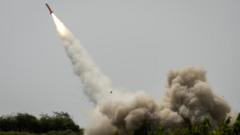At Buckley Space Force Base, the U.S. military's Guardians monitor missile launches globally 24/7, utilizing advanced satellite technology. Amid rising threats, including from China and Russia, the base is pivotal to the U.S.'s missile defense strategies, reflecting on the changing nature of warfare in space.
Inside Buckley Space Force Base: The Guardians of Global Missile Tracking

Inside Buckley Space Force Base: The Guardians of Global Missile Tracking
The BBC receives exclusive access to the U.S. Space Force's operations center in Colorado, revealing insights into missile tracking and potential space conflicts.
At Buckley Space Force Base in Colorado, a battle unfolds of a different kind—one of surveillance and missile tracking. Recently, the BBC gained an unprecedented look inside the facility where U.S. Space Force personnel, known as Guardians, monitor missile launches and track their movements globally.
As they prepare for a simulated launch, orders like "Launch Yemen!" resonate through the room, to which the Guardians promptly respond in unison. This state-of-the-art operations center allows these military personnel to detect missile launches through infrared sensors that pick up the heat emitted during a launch.
This exclusive access reveals the serious nature of their work, particularly since recent real-world events, such as a missile strike from Iran targeting U.S. troops in Qatar, put their capabilities to the test. Colonel Ann Hughes, who oversees operations, recalls the tense atmosphere as the unit tracked Iranian missiles, successfully relaying critical information that helped safeguard American forces stationed abroad.
With increased global tensions, including ongoing conflicts in the Middle East and Europe, Buckley Space Force Base plays a crucial role in the U.S. military's strategic response. Colonel Hughes indicates that the team provides missile warnings to allied forces, emphasizing the heightened alert levels driven by threats from adversaries like Russia and China.
The base is part of an ambitious $175 billion program—dubbed the Golden Dome—envisioned to bolster U.S. missile defense capabilities, drawing inspiration from Israel's Iron Dome. This initiative comes at a time when both Russia and China are enhancing their missile technologies, including hypersonic arms that introduce new challenges to defense mechanisms.
At the heart of the Space Force's mission is the acknowledgment of space as a contested domain. With a rapidly growing number of satellites—expected to grow from 12,000 to over 60,000 in the coming years—the need for superiority in space is more critical than ever. Lieut. Gen. David Miller highlights the significance of staying ahead amidst the evolving aerial landscape, particularly with the emergence of advanced technologies like satellite jamming and anti-satellite weaponry.
Reflecting on the importance of preparedness, Colonel Phoenix Hauser, leader of the Space Forces Intelligence unit, explains that ongoing developments in space weaponry necessitate readiness for all potential outcomes. The future of military engagement, they suggest, may very well include conflicts beyond our planet's atmosphere.
As the U.S. Space Force continues to solidify its role within military operations, General Miller conveys a strong message to any adversary that challenges U.S. space interests. In an arena as dynamic and critical as space, maintaining an advantage is paramount to the defense and security of the nation.



















